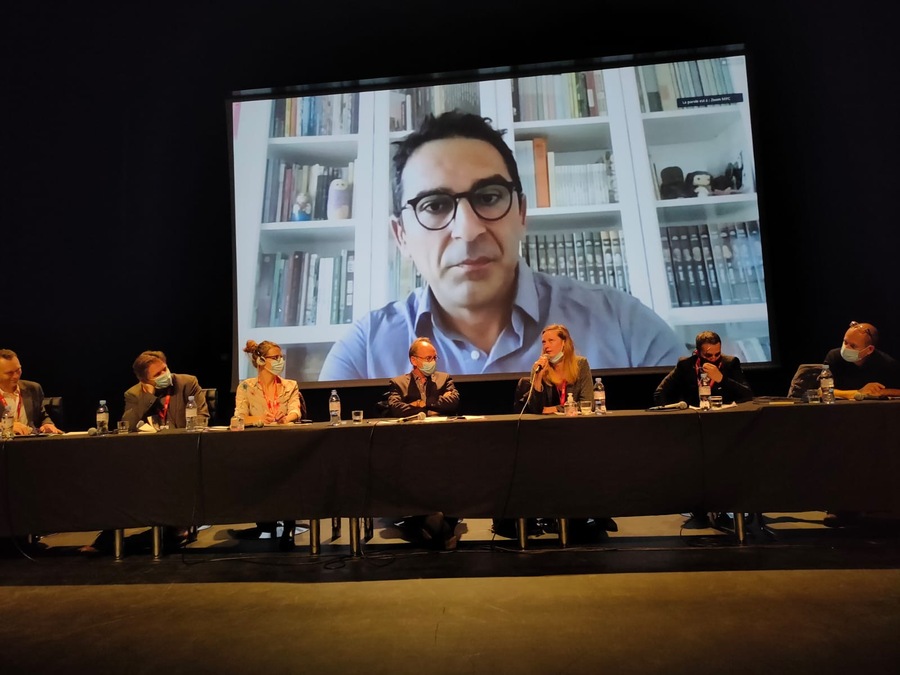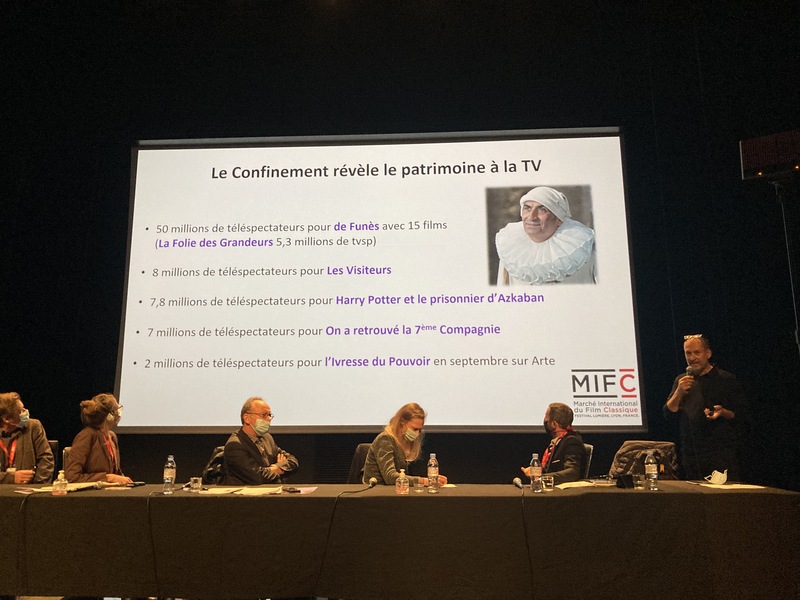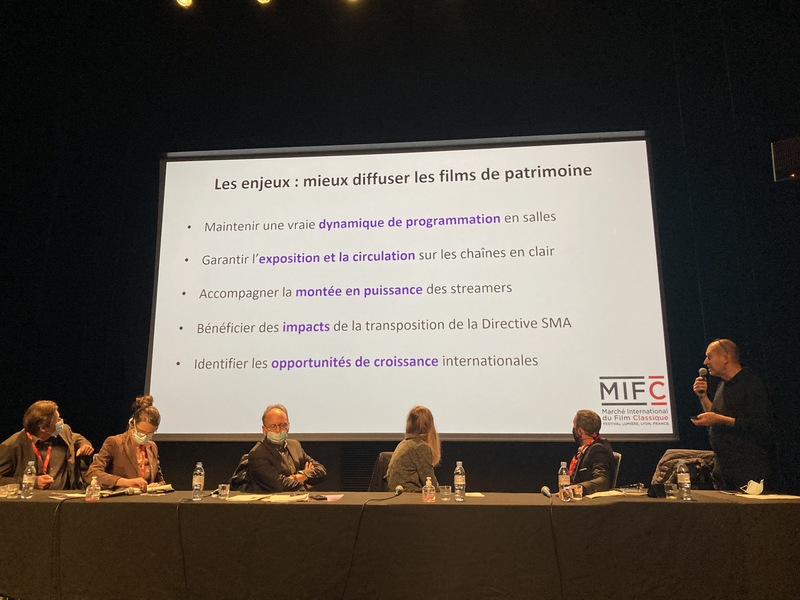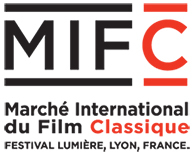The changing heritage sector - part 2
Following this morning's round table, still moderated by the Executive Director of Le Film Français, this second part returned to the problems of exhibiting heritage cinema, particularly on platforms, and the difficulties of its transmission.

This second part of the round table initiated the same morning, still in the Karbone theater, brought together François Aymé, exhibitor at the Jean-Eustache cinema in Pessac and president of Afcae, Guillaume Jouhet, director general of OCS, Natacha Missofe, head of video editions at Potemkine Films, Denis Rostein, general director of UniversCiné, as well as two Lusitanian guests Annette Dujisin, manager of the VàD platform Filmin Portugal, dedicated to independent cinema and Gonçalo Madail, director of the RTP Memoria channel and sub-director of the RTP1 channel of the Portuguese public audiovisual group, around Laurent Cotillon, executive director of Le Film français and Pascal LeChevallier, consultant and founder of What's Hot Media.
It was the latter who opened this round table with some figures. He first noted that the heritage cinema market was really not negligible. Indeed, it represents, in France, 3,100 theatrical releases, 1,100 television broadcasts, 3,000 SVOD releases and 8 million sales of physical media, per year. He also noted the explosion of platforms with some 13 million subscribers, a 52% majority at Netflix, and announced some forecasts given by Digital TV Research, namely that by 2025, we could expect 30 million subscribers, much more distributed over the existing offer. Then he highlighted with a few figures the performance of heritage cinema during containment.

Finally, he gave five major challenges for heritage cinema in the years to come, detailed below.

Secondly, Laurent Cotillon tackled the issues of transmission by following the chronology of the media and starting logically with the cinema. François Aymé, President of Afcae, spoke, underlining the important place that heritage cinema had taken after the post-confinement period, but specifying that this success, however praiseworthy, was above all arithmetic: more theaters available, more admissions. However, he specified that overall, and this is a trend that has been confirmed with the Covid crisis and the numerous postponements of "new" film releases, arthouse films resisted much better at the box office than their mainstream counterpart "because it attracts a loyal and assiduous audience, and within arthouse, heritage has resisted even better because it is aimed at loyal movie-goers. »
As far as transmission is concerned, the one who also runs the cinema Jean-Eustache in Pessac remains more dubious. In response to a question raised that very morning about the loss of young people between 15 and 25 years old to video games, he confirmed the absence of this age group, speaking of a regression in cinephilia and its transmission. For him, it is necessary and urgent to develop image education programs that currently "only concern 15% of an age group" but also to improve teacher training and the role of the media in this work of transmission. A reflection that did not meet with unanimous approval, neither in the room nor in the present panel. Natacha Missoffe, head of video editing at Potemkine Films noted a touch of condescension in these remarks and said that it was also our duty to arouse the curiosity of young people by adapting to them and not the other way around.
The DVD/Blu-ray takes over with the intervention of the latter who returns to the strength of physical video which allows a more in-depth intervention on the subject of heritage, more over time. For her, the strength of this media is also the editorial work, which is also necessary for sales. However, she explains that its economy works on GMs, but the mandates are often limited and do not extend to other modes of video distribution such as VoD or SVoD, which leads to concerns about profitability: "We would gain in coherence and economy if we could acquire all the video rights," she explains, while understanding the logic of the rights holders. She also stressed the importance of media libraries in the video market, as well as certain specialized sales outlets (Cultura, La Fnac, etc.) that allow DVD/Blu-Ray to exist in the eyes of the general public. To which Pascal LeChevallier added the emergence of publishers' online stores allowing DTC. But for the person in charge of the video editions at Potemkine Films, it is also necessary to support, financially, the physical points of sales, especially the small ones, which have a real prescribing role.
On the side of TV broadcasting, Guillaume Jouhet, OCS General Manager, who gave an overview of the group's different broadcasting channels (linear, non-linear and OTT), said that the heritage was particularly consumed on the linear, up to 25% of viewers, "where they are only 10% to solicit them on the non-linear" he adds. Always enthusiastic, he even specifies that heritage cinema represents 29 of the top 100 annual audiences. The most watched films? American westerns and war movies. A statement shared by his Portuguese colleague Gonçalo Mandail, director of the RTP Memoria channel and deputy director of the RTP1 channel of the Portuguese public audiovisual group. But where access to heritage works is not a concern for the French broadcaster, the Lusitanian specifies that it is not the same in Portugal. Indeed, it has to rely on a strong partnership with the film library, particularly because few local classic films have been digitized.
This problem is obviously reflected in Portuguese VàD platforms such as Filmin, represented at this round table by its manager, Annette Dujisin. This constraint is also reinforced by a very closed local system, since most of the country's heritage works are held by small majors that do not wish to share them in order to privilege their channels.
However, Annette Dujisin and Denis Rostein, UniversCiné's general manager, agree that while heritage is essential to their catalog, it is not necessarily a product of appeal. However, it represents 1/3 of the visionaries on the Lusitanian platform and 46% on the French one. UniversCiné is also, since three weeks, a SVoD platform which already counts 800 films and some 2200 subscribers. And if it is still impossible to have the necessary hindsight to draw definitive conclusions, Denis Rostein has already observed that it is more expensive to obtain broadcasting rights in SVoD than in TVoD where the revenues are shared. He explains that it is important that the rights holders show "benevolence".
Like Natacha Missoffe a little earlier, the Director General of UniversCiné specified that editorialization was key: "It is easy to put films in pipes but editorializing them is better, it allows us to reach new audiences". This search for new audiences also involves experimenting with AVoD (Advertised Video on Demand). A model that is seriously starting to develop on the other side of the Atlantic, and one that Pascal LeChevallier would regret seeing Europe miss out on. For some speakers, it is a way to introduce audiences to legal dematerialized consumption, or even to revalorize less prestigious, less well-known titles, "bottom of the catalogs" as it has been said. A method that Natache Missoffe somewhat disapproves of, as she fears that with this model of free content, it could create a bad habit among the public, implying that everything should be free. "This can be problematic, because unaccustoming people to paying to watch films devalues the work that is done around these films and to release them."



